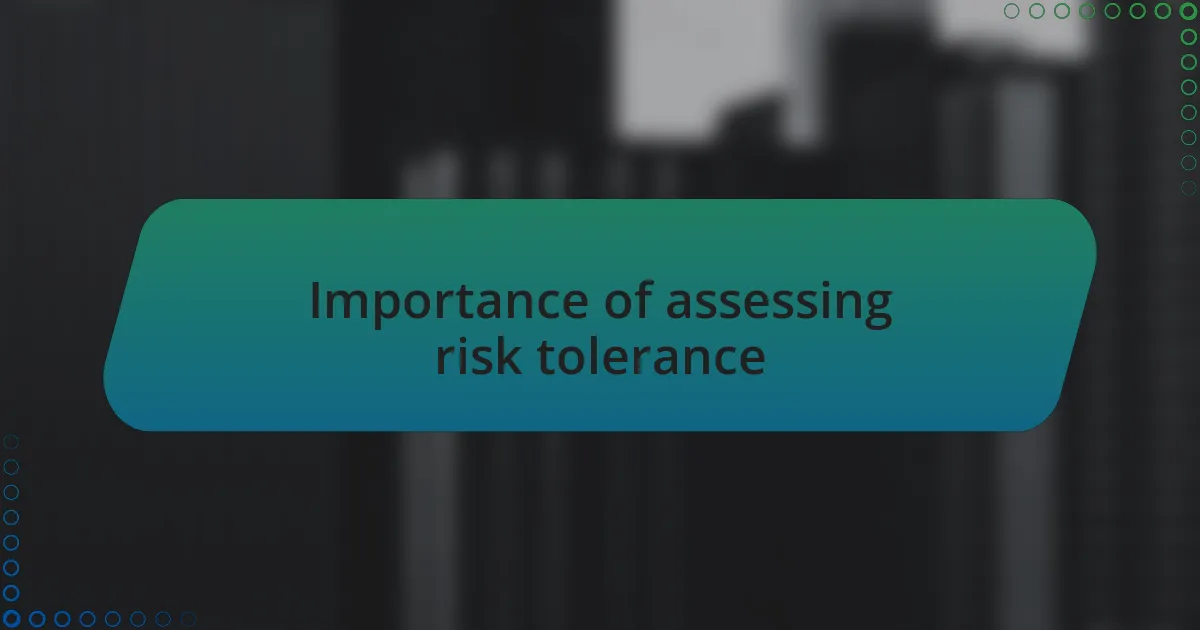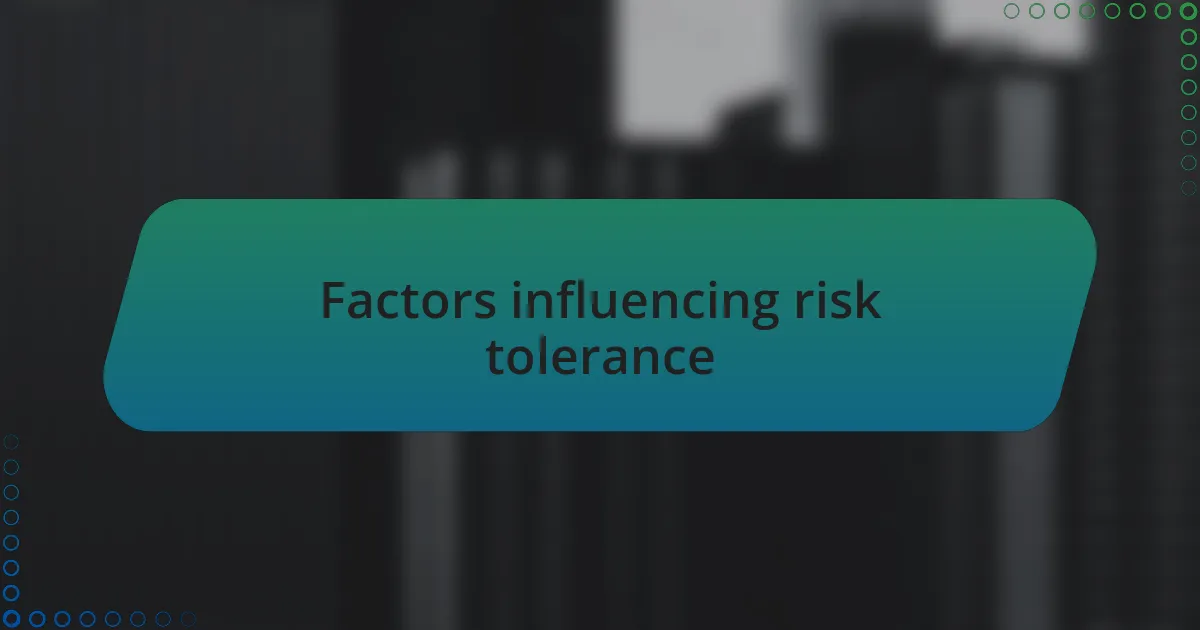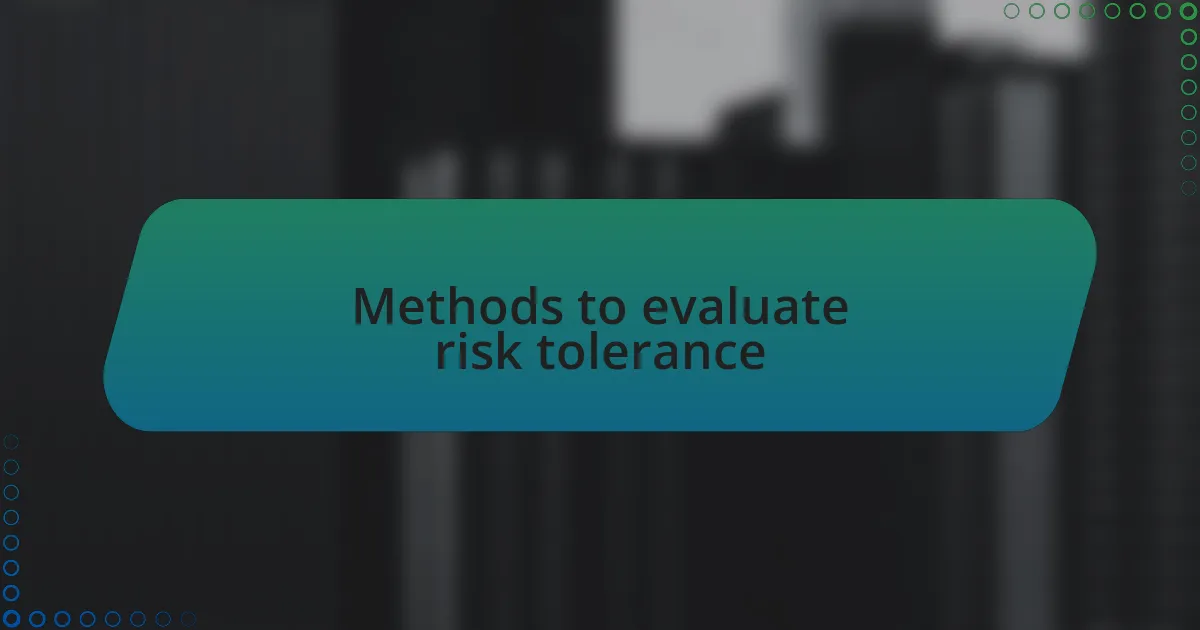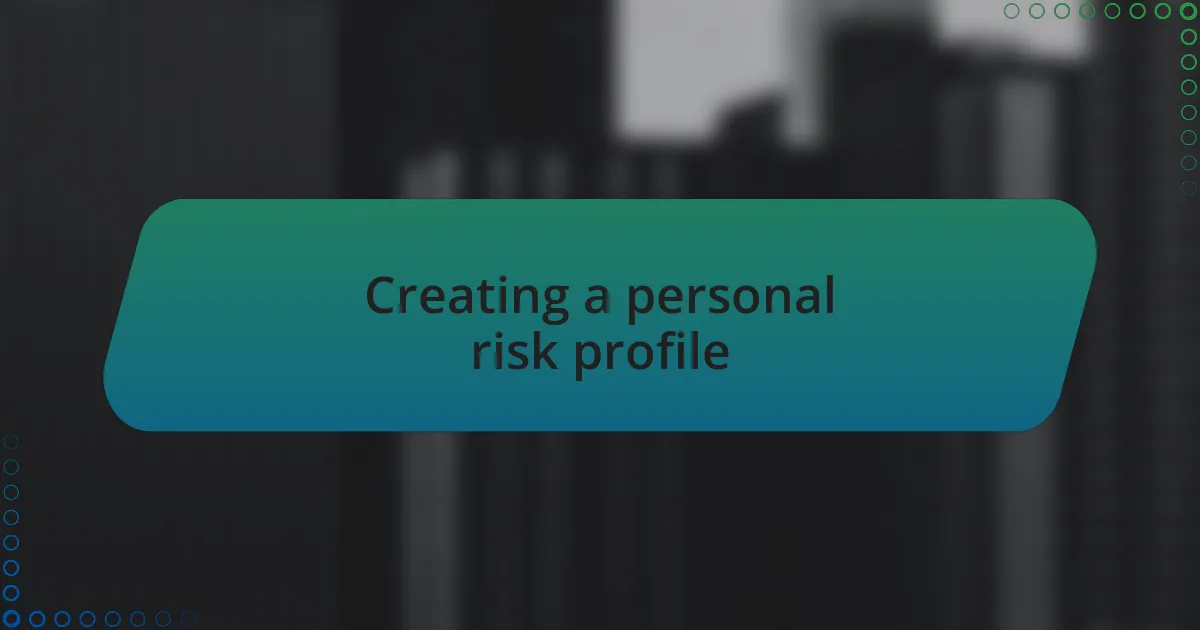Key takeaways:
- Understanding risk tolerance is vital for creating tailored investment strategies that align with personal financial goals and emotional comfort.
- Factors such as age, psychological experiences, and personal circumstances significantly influence an individual’s risk appetite.
- Regularly reassessing risk tolerance is essential, as life changes and market conditions can alter one’s investment approach.
- Utilizing personal discussions, hypothetical scenarios, and structured questionnaires can effectively evaluate risk tolerance and guide investment decisions.
Understanding risk tolerance in investing
Understanding risk tolerance in investing is crucial, as it reflects how much uncertainty an investor can comfortably endure. I often think back to my early days in the investment world when I felt the anxiety of market swings. It was a learning curve for me; I had to assess my emotional responses to losses and gains to truly understand my risk appetite.
When I talk to clients about their risk tolerance, I emphasize the importance of self-reflection. For instance, just last year, a client admitted to me that they felt paralyzed by potential losses. That conversation opened up a deeper understanding of their financial goals and fears, ultimately shaping a more tailored investment strategy. I always ask, how would you feel if your investment dropped by 20% tomorrow? The answers reveal a lot about their comfort level.
Risk tolerance isn’t just a number; it’s a blend of personal experiences and emotional responses. I once had a friend who lost a significant amount in a market downturn and became overly cautious afterward. It’s fascinating how past experiences can influence current decisions. By recognizing these emotional triggers, investors can align their strategies with their true risk tolerance, leading to more confidence in their investment journey.

Importance of assessing risk tolerance
Determining one’s risk tolerance is essential because it directly impacts investment choices and long-term success. I remember working with a young couple who dreamt of buying their first home but were hesitant to invest heavily in stocks due to their fear of losing money. When we discussed their aspirations and the potential risks involved, they began to realize how understanding and managing their risk tolerance could open doors to more aggressive investment options that aligned with their goals.
Recognizing risk tolerance helps create a balanced and appropriate investment strategy. For example, I once guided a retiree who initially wanted to keep all their savings in cash due to fears of market fluctuations. After discussing their lifestyle needs and the importance of inflation protection, they acknowledged the need to embrace a moderate level of risk for the sake of their long-term financial health. Isn’t it eye-opening how a simple discussion can shift someone’s entire perspective on risk?
Without assessing risk tolerance, investors run the risk of choosing unsuitable portfolios that can lead to anxiety or even financial loss. I recall my own experience when I dove headfirst into a high-risk investment without evaluating my comfort level. The stress I felt during market dips was unbearable and taught me that understanding personal risk tolerance is not just beneficial, but essential for maintaining peace of mind while investing.

Factors influencing risk tolerance
When assessing risk tolerance, several factors come into play, including age, financial situation, and investment goals. I’ve seen young investors, eager to grow their wealth, often overlook the importance of their time horizon. For instance, a client in their twenties may feel invulnerable, willing to embrace volatility, while someone nearing retirement often prioritizes stability. Isn’t it interesting how our age can dramatically shift our perspective on risk?
Psychological factors also wield significant influence over how individuals handle risk. I once worked with a client who had experienced substantial losses in the stock market, leading to a serious aversion to any risk. Their emotional scars made it difficult to consider even moderate investments, despite their long-term financial needs advocating for a more balanced approach. Can past experiences color our current decision-making more than we realize?
Lastly, personal circumstances—such as family responsibilities, job stability, and overall health—can affect one’s risk appetite. I remember advising a single parent who felt compelled to play it safe due to financial pressures at home. After some reflection and discussion, we identified growth opportunities that didn’t compromise their peace of mind, showcasing how personal circumstances can guide suitable investment strategies. It raises the question: how well do we understand the interplay between our lives and our investment choices?

Methods to evaluate risk tolerance
Assessing risk tolerance requires a multifaceted approach. One effective method I often use is a detailed questionnaire that not only gauges a client’s financial situation but also delves into their emotional response to risk. I recall a time when a detailed assessment revealed that a seemingly aggressive investor was actually risk-averse at heart. This discrepancy highlighted how misunderstandings about one’s risk appetite can lead to poor investment choices.
Another approach involves mock investment scenarios. I like to present clients with various hypothetical market conditions and ask how they would react. During one session, a client was surprised to find that they panicked when faced with a significant market dip in the simulation, despite confidently claiming they could weather any storm. This experience illuminated the gap between theory and practice, prompting a deeper discussion about their true risk tolerance.
Lastly, personal discussions about long-term aspirations can be immensely revealing. I often ask clients what their financial dreams are, such as retiring early or funding a child’s education. I once asked a couple about their retirement plans, and when they shared their desire to travel the world, it became clear that their risk tolerance had to shift to accommodate that vision. It’s fascinating how defining our goals can reshape our investment strategies—what dreams do you have that might influence your approach to risk?

Creating a personal risk profile
Creating a personal risk profile starts with understanding your financial situation, but it goes much deeper than numbers alone. In my experience, discussing past investment experiences can provide invaluable insights. I remember working with a client who had lost money in a previous market downturn and was still haunted by that experience. Their reluctance to take on risk was clear, and it shaped how we approached their investment strategy.
I often encourage clients to visualize their future and consider how their risk tolerance aligns with their life goals. During one session, a young professional expressed a desire to buy a house in five years, and this discussion prompted us to reassess their willingness to take risks. Their dream added a layer of urgency to their financial planning and ultimately led them to opt for a more balanced investment strategy that aligned better with their aspirations.
Additionally, exploring emotional triggers can be pivotal in creating a solid risk profile. Once, a client confided in me about their anxiety regarding market fluctuations. This conversation made it clear that even a conservative approach felt too risky for them. It was a turning point where we shifted focus to more stable, income-generating investments, highlighting the importance of comfort in one’s investment choices—how comfortable do you feel with your current portfolio?

Adjusting risk tolerance over time
As life changes, so does our risk tolerance—a truth I’ve seen play out time and again with my clients. For example, when a client recently welcomed their first child, their priorities shifted dramatically. They now wanted a more conservative investment approach, reflecting their desire for stability and security.
I often find that big life events, like marriage, career changes, or even retirement, can be catalysts for reassessing risk tolerance. One client faced this head-on when they transitioned from a high-stress job to early retirement. The relief they felt was palpable, yet it also made them more apprehensive about market risk. Recognizing this shift allowed us to adjust their portfolio to more conservative investments that provided a sense of peace.
Ultimately, I encourage a regular review of risk tolerance, as personal circumstances and market conditions are in constant flux. How often do you take the time to reflect on your current financial situation in relation to your evolving goals? By staying attuned to these factors, I believe investors can navigate changes more effectively, aligning their strategies with their life journey.

Practical steps for risk assessment
When it comes to assessing risk tolerance, I always start with a candid conversation. I often ask clients about their past investment experiences, especially the moments when they felt anxious or relieved. This introspective look at emotions can be eye-opening—sometimes, it reveals a discomfort with loss that they weren’t consciously aware of. Have you ever thought about how your emotions around money impact your decisions?
Next, I find it helpful to walk clients through hypothetical scenarios. For instance, I once asked a client to imagine a sudden market downturn and how it would affect their peace of mind. As they visualized the situation, their responses often illuminated their true comfort levels with risk. Such exercises not only clarify preferences but also foster a deeper understanding of one’s financial resilience.
Lastly, I recommend utilizing risk assessment tools or questionnaires. I’ve seen clients gain clarity through structured evaluations that break down their investment philosophy into quantifiable metrics. These insights can sometimes be the catalyst for change. How well do you know your own risk threshold? It’s a fundamental question that can reshape your investment strategy significantly.






